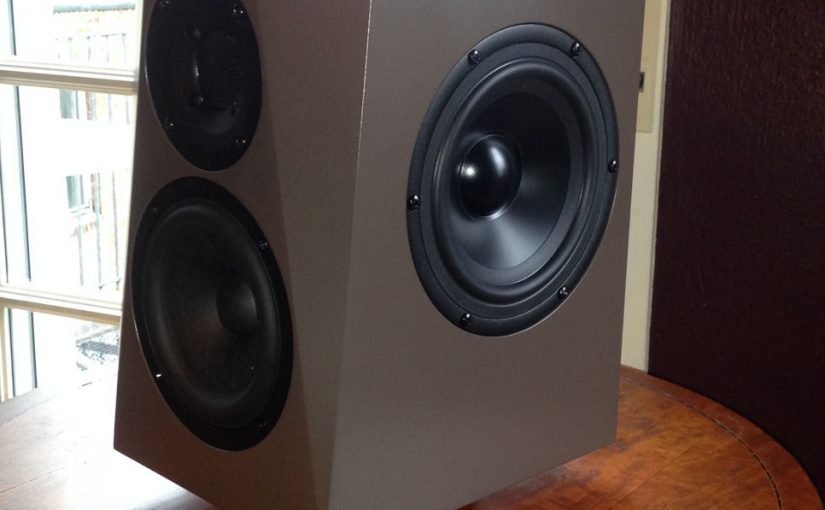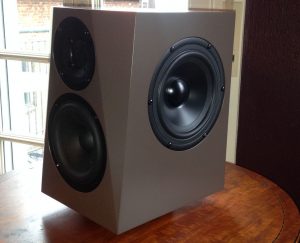Here is a short summary of my experiences in the construction of the DXT-MON. For me as a "newbie" that was a great experience. Also to the effect that as a "city man" without existing workshop and appropriate tools can come to an absolutely convincing result.
I do not think our bar was set low. In the past, an 2.5 walkway speaker from an Italian manufacturer was used. Cost: 3.600 €. In our living room we hear about 25m² with 3m ceiling height.
One day I came - apparently on the edge of mental derangement, what was it that rode me? - on the idea of expanding a driver. That was a mistake that started a thought process. Behind the admittedly “chic” looking leather / MDF front, I found rather disillusionment inside: no insulation, the switch was listlessly “tacked” and the internal milling on the TMT's wasn't really there either.
That left an “unemotional” impression on me. At the same time I made the decision to actively deal with "Plan B": I ask around for other speakers ...
In addition, I came to the realization that we cannot optimally position the existing floorstanding speakers - the existing space simply does not provide that. The loudspeaker cannot help it, but more should be discussed / questioned about it during the consultation at the local dealer.
I did not get any further after many studio visits. The most pleasing, passive solution over a closed compact was already well above the purchase price of the then floorstanding loudspeakers. The other alternative: fully active solution. Had but my tube amplifier as a victim result, since no pre-out is available. I did not bring that over my heart. The fully active variant would not have been so cheap and my better half immediately raised the objection that the full-time people look "modest".
Somehow, the reference to DIY is missing, right? Right. I have not had that to date
Time considered. Theoretically I was informed and knew that there are solutions for the self-construction of loudspeakers. Also how these are technically implemented. And honestly, the "rocket-science" in the speaker construction also interested me somehow.
What then speaks against self-construction? Well, nothing at all. Except maybe:
No usable workshop, too few suitable tools, too many unsuitable tools, soldering the crossover - I'm laughing, changing lightbulbs is still easy and the woodwork from elementary school that I remembered went through with "goes like this" . Oh yes, and I don't really have any time either.
Actually, all traffic lights jump to "red" immediately. As a result, you keep your hands off it and end the project. But not so with people who have their home in the orbit of Stuttgart 21 ... You are used to different things, you step on the gas!
So, make up your mind - it will be built by yourself. I then spent almost a year looking for a suitable concept. In addition, there were considerations as to how I can have the pending work done by professionals as far as possible.
Basically, I was amazed how many building proposals are available on the net. Many of them are well documented. Unfortunately, one rarely finds the possibility that one can enjoy listening to a kit.
At some point I played Russian Roulette and made up my mind to take up the concept most suitable for my impression. In my opinion, this was the DXT-MON of Alexander Heißmann among the last 5 candidates.
I bought the tree cap and asked Mr. Hotman for a partner who made me the case. And indeed tutti kompli. I was then made aware of the joinery Thomaier, which turned out in retrospect as the right place.
Then it actually started already. The housings were commissioned and I ordered all the missing pieces of the puzzle bit by bit.
Except for the insulation, I strictly adhered to the plan of Hr. Heißmann. Only the story with the bitumen was suspect to me. The toenails opened up as I imagined liquefying the bitumen with a hot air gun. The alternative was then found: Alubutyl in self-adhesive execution.
The doubling with 2 layers alubutyl and additionally 4mm plywood was very easy and feasible without problems via the assembly hatch. Which was also very helpful: you could understand the result very well by the well-known in the net "knocking test". It was unbelievable how well the doubling worked.
Then the walk to a professional painter followed. Happy coincidence here: the painter also likes to hear stereo and was immediately hooked by the project. He then invested a whopping eight hours of work and presented me within a week an absolute top result. The drivers I have deposited with the painter, so that he could always check the passability.
And then it was time: "all in" as in poker! Final result:
How does it sound Well. Damn good. I am not missing anything - on the contrary! 100 points - everything done right. Given their size, the speakers can be integrated very well into the living room.
Distance to the back wall with us: about 60cm. Passive membrane (without additional weight) directed inwards. At the lineup I will change something.
I don't write any more now. All impressions are based on our circumstances, so it's difficult to transfer ...
Conclusion
Fits like a fist on our eyes, the speakers are really fun. Many Thanks!
Desirable (from my point of view):
@ SEAS: Sells the tweeter + 10,00 € and installed on the waveguide instead of plastic, please a more valuable material.
What would I do differently:
Definitely choose MPX for the housings. MDF comes to me personally something "strange".
Given the cost of painting (in relation to the housings), I would aim for a different solution in the future.




The insulation with 2 layers alubutyl and a firm top layer is optimal. For this I had once made investigations. You do not have to melt the bitumen, a roofing membrane made of Elastomerbitumen is quickly melted and pressed, but clearly more complex.